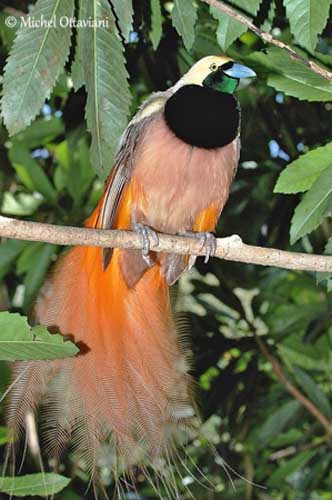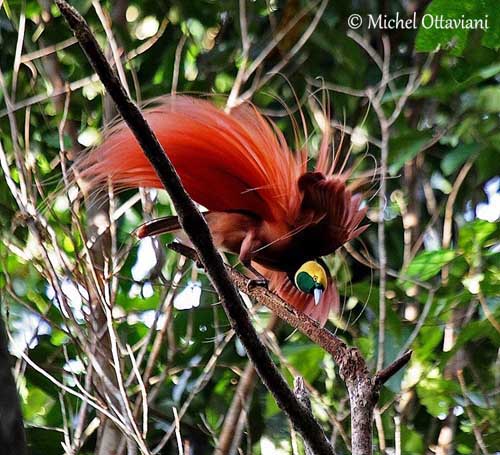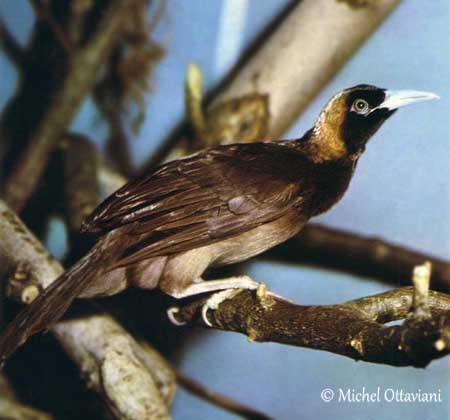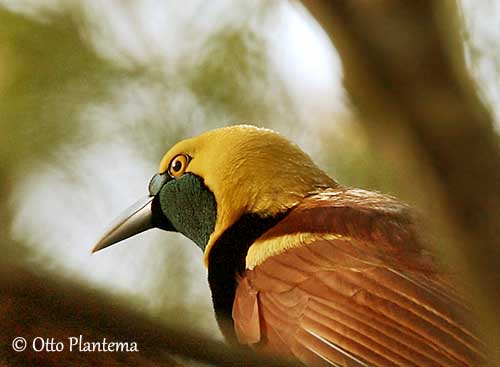
This nest is an open cup-shaped structure made with leaves, pieces of leaf, rootlets, stems, orchids or ferns and plant fibres. The lining is similar to horsehair, but probably made with plant fibres. Such nest is built between 2 and 11 metres above the ground in tree branches.
The female lays 1-2 pinkish-buff eggs with some fine darker markings. The incubation lasts 18-20 days by female alone. The chicks are fed with arthropods, and later, fruits are added to their diet. They leave the nest about 17-20 days after hatching. The male does not take part in nesting duties.
DIET:
The Raggiana Bird-of-paradise feeds mainly on fruits such as capsular fruits and figs (Ficus). It also takes arthropods.
As this species does not digest the seeds, it takes an important part in seed dispersal.
PROTECTION / THREATS / STATUS:
The Raggiana Bird-of-paradise is common and widespread in its range, and there is no evidence of any important potential threat.
This species is not currently threatened.
Fr: Paradisier de Raggi
All : Raggiparadiesvogel
Esp: Ave-del-paraíso de Raggi
Ital : Uccello del Paradiso del marchese De Raggi
Nd: Raggi-paradijsvogel
Sd: Raggianaparadisfågel
Photographers:
Michel Ottaviani
Le site de Michel Ottaviani
Otto Plantema
Trips around the world
Text by Nicole Bouglouan
Sources:
HANDBOOK OF THE BIRDS OF THE WORLD Vol 14 by Josep del Hoyo-Andrew Elliot-David Christie - Lynx Edicions – ISBN: 9788496553507
Les Oiseaux de paradis – Histoire Naturelle et photographies - par Michel Ottaviani - Editions Prin, France – ISBN : 2-909136-40-X
L’ENCYCLOPEDIE MONDIALE DES OISEAUX - Dr Christopher M. Perrins - BORDAS - ISBN: 2040185607
BirdLife International (BirdLife International)
Raggiana Bird-of-paradise
Paradisaea raggiana
Passeriforme Order – Paradisaeidae Family
BIOMETRICS:
Length: Male: 34 cm, excluding tail wires of about 60 cm.
Length: Female: 33 cm
Weight: 133-220 g
DESCRIPTION:
The Raggiana Bird-of-paradise is a beautiful bird which performs conspicuous courtship displays. Its superb plumage is enhanced by different postures and movements.
This species is the national bird of Papua-New-Guinea.
The adult male has very nice head pattern with iridescent emerald-green washed yellow lores, forehead, ear-coverts, malar area, chin and throat. The rest of the head, nape and hindneck, are pale orange-yellow with pale silver gloss. We can see a narrow collar, formed by yellow colour extension across the lower throat and from hindneck onto mantle where it turns light brown-maroon.
The rest of the upperparts, upperwing and tail, are dark brown with maroon tinge on back, rump and uppertail-coverts. On the upperwing, there is a pale orange-yellow wingbar on the lesser coverts, and some orange-yellow wash on the outer edges of the greater coverts. On the tail, the two central rectrices are elongated and reduced to blackish wires lacking vanes except at bases.
On the underparts, the upperbreast is blackish brown with dark coppery-bronze iridescence, and contrasts with the medium brown belly. Thighs, vent and undertail-coverts become paler, more pinkish brown. The undertail-coverts are filaments and reach the half tail length.
The flank feathers are orange-crimson with buffy-white tips on the underside, and rusty-brown tips on the upperside. These feathers are elongated too, ending into filaments, more reddish above.
The heavy bill is pale bluish-grey. The eyes are yellow. Legs and feet are pale fleshy-brown.

The female is smaller and has shorter wings. The central rectrices are shorter and narrower, and more pointed than the other tail feathers. She has dark brown face, ear-coverts, chin and throat, whereas crown, rear and sides of neck and foreneck collar are dark buff-yellow. This collar turns pale pinkish-brown on the underparts. Central belly is paler.
The juvenile is dark brownish until four months of age. Then, it becomes similar to the adult female. It needs about 7 years to acquire the full adult plumage.
We can find four subspecies: salvadori, intermedia, augustaevictoriae and raggiana (described above).
The race “augustaevictoriae” (displayed beneath), has apricot-orange flank feathers, paler belly and narrow yellow throat-collar. The female is much paler than nominate.

HABITAT:
The Raggiana Bird-of-paradise frequents forested areas such as lowland forest, lower montane forest, secondary growth, edges, gardens, trees in open deforested areas.
Usually, the adult males remain inside the forest. This species can be seen from sea-level to 1500 metres of elevation.
The leks may occur in various habitat types, but usually in prominent location, but also at flatter sites.
RANGE:
The Raggiana Bird-of-paradise is found in S and NE New Guinea.
This species is probably resident in its range.
BEHAVIOUR:
The Raggiana Bird-of-paradise is mainly frugivorous, but it also takes arthropods. It forages at mid-canopy in the forest. Insects are found in bark crevices and foliage by gleaning and probing the rotten wood.
It feeds on capsular fruits and figs (Ficus), and uses the feet as tools in order to hold and manipulate the food items. It is able to extract the seeds from the capsule. It does not digest them, and play an important role in seed dispersal.
But the Raggiana Bird-of-paradise performs spectacular courtship displays. Several males gather at leks, often in the high branches of tall trees or on prominent place such as high ridge crest, but they also occur in valleys or flat landscapes.
The magnificent nuptial plumage of the males is exposed to females through three fundamental phases: convergence display, static display and copulation display. Their calls can be heard from a distance.

During the Convergence display the dispersed males quickly return to their perches at the lek when one or several females are approaching. This phase is accompanied by loud calls. The males are very excited and noisy, hopping, flapping their wings and moving their long feathers.
This sequence is followed by a quieter period during which each male tries to be better than its rivals, and enhances its beautiful ornaments by different movements and postures, while giving a unique metallic note.
And finally, the copulation occurs on the branch after an approach by the male, during which it flutters the wings and beats the carpal joints together, producing some noise.
This posture makes more conspicuous the beautiful elongated flank feathers of the adult males. This is followed by a “static display” during which these feathers are raised while the head is deeply lowered.
During this phase, the females may compare the size and plumage of several males while they hold the same posture.
The leks may gather up to ten adult males, and this place may be long-lived, to more than 20 years.
FLIGHT:
The Raggiana Bird-of-paradise performs an undulating and floppy flight when moving inside the forest. The wings are rounded with some modified outer primaries, in order to produce mechanical sounds during the courtship displays.
REPRODUCTION:
The breeding season may vary according to the range, but usually occurs between April and December. The display period varies too with the location, with a peak between June and October. The males are polygamous, while the females build the nest alone.

